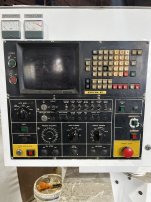davidwenrich
Aluminum
- Joined
- Oct 27, 2015
I have been working on this machine for quite some time, but I have been making progress. I can now write and execute a program. Movement and tool change commands work. The problem I am battling now is no spindle speed control via NC. Analog controls work spindle speeds fine. (I assume a potentiometer) When spindle is commanded on, it starts to turn, spins up to around 300ish RPM and then immediately goes to around 52-53 RPM and holds steady until dwell time in program is complete, then stops, reverses as commanded and does the same in reverse. I have manually altered input bits at the DAC on the spindle control board, and if a bit is pulled low the RPM increases as I assume it should.(all high when spindle turning at aforementioned 52-53 rpm, which should be zero RPM if I’m not mistaken) I had to change parameters here and there, and replace main PCB for controller to get this far. Z axis was only moving 1/2 the indicated distance (as if it were X in diameter) Changed Pulse multiplier parameter for that axis. Now position displays correct distance within .002” over 25.4 mm (I don’t have a metric long travel indicator) Main PCB changed to fix a no movement at all problem. The spindle speed problem has me stumps though. RPM is displayed correctly on the command screen I.e. 50 is 50, 1000 is 1000 when commanded from analog knob. Can anyone tell me about the tacho/generator/orientation pulse operation? Maybe position cannot be determined so it will not spin up? Makes no sense to me that rpm is incorrect, but program runs with no alarms/errors.




